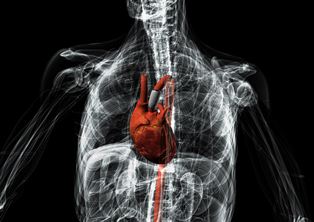3D-printed tubular pump provides alternative to heart transplant
11 September 2013
A custom-designed tubular pump for implanting into the aortic artery to support a failing heart is being developed by researchers at Nottingham Trent University and Nottingham University Hospitals NHS Trust.
A smart material which expands when a voltage is applied to it would surround an inner woven tube to act as a pump. The tube would be made using origami-type auxetic techniques which allow it to collapse and expand. Using 3D printing techniques, the research team aims for the smart pump to be tailor-made to each patient by using MRI scan data.
The device - for which a patent has been filed - would create a counter blood-flow by pumping out of phase with the diseased heart. When the heart fills with blood, the woven tube would contract to increase pressure in the heart. When the heart then pumps oxygenated blood around the body, the tube would expand to release the pressure and increase the blood flow.

An artist's impression of the smart aortic pump
being
developed by Nottingham Trent University and Nottingham
University Hospitals
The pump would be powered by an implanted battery and would be entirely self-contained, without the need for the patient to be hospital bedbound or connected to large machinery via catheters and transdermal lines.
Dr Philip Breedon, a reader in smart technologies at Nottingham Trent University’s School of Architecture, Design and the Built Environment, who is leading the research team, said: “This device could really be ground-breaking and more effective than any other therapy currently being used around the world. Chronic heart failure is a major health challenge and up to 40% of sufferers die within the first year. The best form of treatment is a heart transplant, but the demand by far outweighs the supply as around 160,000 people require one in Europe each year, but only 600 donor hearts are available.
“The technology currently used to help people with acute heart failure can only be used for a few days and involves the patient being attached to large external machines which need to be plugged into the mains power supply. The smart aortic graft has the potential to not only extend a patient’s life, but also to provide them with mobility, comfort and a reduced need for carers.”
Associate Professor David Richens, consultant cardiac surgeon at Nottingham University Hospitals NHS Trust, said, “The smart aortic graft is a unique, cutting-edge solution to a global health problem and promises to be cheaper and better than current devices. The cost of heart failure in the UK alone is £625 million a year and, according to the World Heart Failure Society, incidences of heart failure are steadily rising around the globe.
“The smart aortic graft would revolutionise the way people are treated and the technologies which underpin the design have the potential to transform the treatment of other diseases, such as Esophageal Achalasia.
“Designs such as this are revealing the true potential of smart materials in medical product design. This technology really could be the start of a new beginning in the way we use equipment to help save people’s lives.”
Further information
The project is supported by the Nottingham University Hospitals Innovation seed fund managed by the Department of Research and Innovation. The University of Nottingham is also collaborating on the project.
Research projects relating to the device will go on show for Nottingham Trent University’s Art and Design Postgraduate Expo 2013 on 23 Sept to 4 Oct 2013.
See the NTU website for more information >>